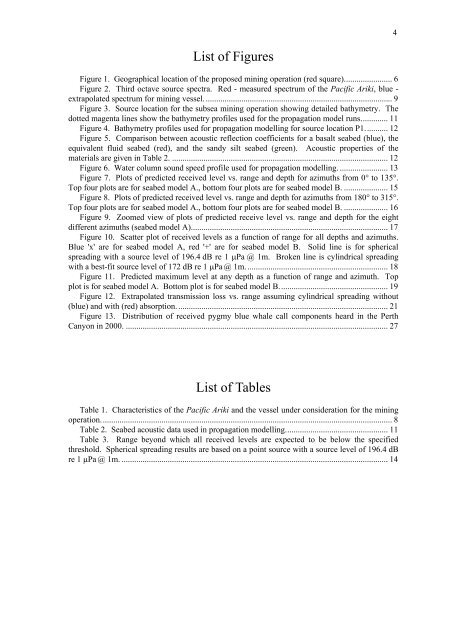Appendices 5-13 - Nautilus Cares - Nautilus Minerals
Appendices 5-13 - Nautilus Cares - Nautilus Minerals
Appendices 5-13 - Nautilus Cares - Nautilus Minerals
You also want an ePaper? Increase the reach of your titles
YUMPU automatically turns print PDFs into web optimized ePapers that Google loves.
List of Figures<br />
Figure 1. Geographical location of the proposed mining operation (red square)....................... 6<br />
Figure 2. Third octave source spectra. Red - measured spectrum of the Pacific Ariki, blue -<br />
extrapolated spectrum for mining vessel.......................................................................................... 9<br />
Figure 3. Source location for the subsea mining operation showing detailed bathymetry. The<br />
dotted magenta lines show the bathymetry profiles used for the propagation model runs............. 11<br />
Figure 4. Bathymetry profiles used for propagation modelling for source location P1........... 12<br />
Figure 5. Comparison between acoustic reflection coefficients for a basalt seabed (blue), the<br />
equivalent fluid seabed (red), and the sandy silt seabed (green). Acoustic properties of the<br />
materials are given in Table 2. ....................................................................................................... 12<br />
Figure 6. Water column sound speed profile used for propagation modelling. ....................... <strong>13</strong><br />
Figure 7. Plots of predicted received level vs. range and depth for azimuths from 0! to <strong>13</strong>5!.<br />
Top four plots are for seabed model A., bottom four plots are for seabed model B. ..................... 15<br />
Figure 8. Plots of predicted received level vs. range and depth for azimuths from 180! to 315!.<br />
Top four plots are for seabed model A., bottom four plots are for seabed model B. ..................... 16<br />
Figure 9. Zoomed view of plots of predicted receive level vs. range and depth for the eight<br />
different azimuths (seabed model A).............................................................................................. 17<br />
Figure 10. Scatter plot of received levels as a function of range for all depths and azimuths.<br />
Blue 'x' are for seabed model A, red '+' are for seabed model B. Solid line is for spherical<br />
spreading with a source level of 196.4 dB re 1 "Pa @ 1m. Broken line is cylindrical spreading<br />
with a best-fit source level of 172 dB re 1 "Pa @ 1m. ................................................................... 18<br />
Figure 11. Predicted maximum level at any depth as a function of range and azimuth. Top<br />
plot is for seabed model A. Bottom plot is for seabed model B.................................................... 19<br />
Figure 12. Extrapolated transmission loss vs. range assuming cylindrical spreading without<br />
(blue) and with (red) absorption. .................................................................................................... 21<br />
Figure <strong>13</strong>. Distribution of received pygmy blue whale call components heard in the Perth<br />
Canyon in 2000. ............................................................................................................................. 27<br />
List of Tables<br />
Table 1. Characteristics of the Pacific Ariki and the vessel under consideration for the mining<br />
operation........................................................................................................................................... 8<br />
Table 2. Seabed acoustic data used in propagation modelling................................................. 11<br />
Table 3. Range beyond which all received levels are expected to be below the specified<br />
threshold. Spherical spreading results are based on a point source with a source level of 196.4 dB<br />
re 1 "Pa @ 1m. ............................................................................................................................... 14<br />
4


